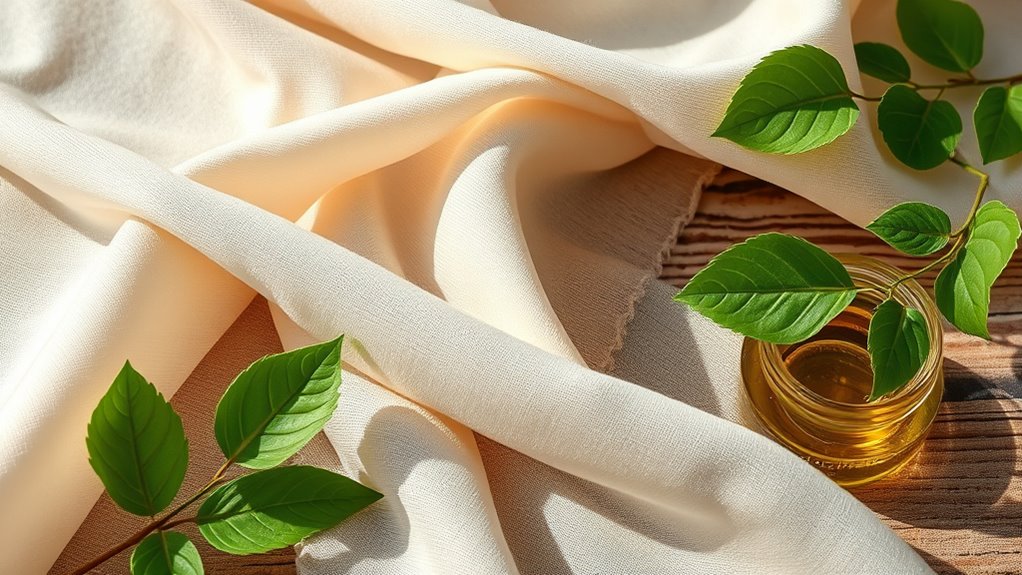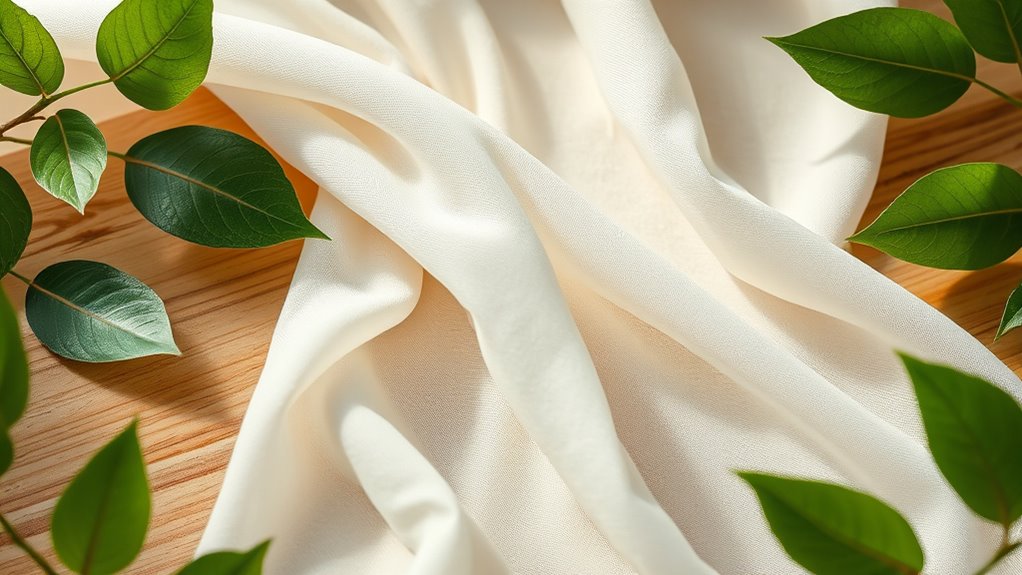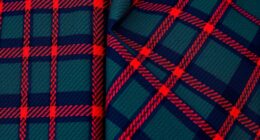Lyocell, also known as Tencel, is an eco-friendly fabric made through a sustainable process that minimizes environmental harm. It’s created by dissolving cellulose from responsibly harvested wood pulp, then recycling most of the solvents used. This reduces waste, pollution, and energy consumption. The fabric is soft, breathable, and biodegradable, making it a great alternative to rayon and synthetic fibers. To discover how Lyocell supports sustainability and its benefits, keep exploring its innovative production and eco advantages.
Key Takeaways
- Lyocell (Tencel) is an eco-friendly fabric made from sustainably harvested wood pulp using a closed-loop process.
- It involves dissolving cellulose in a solvent that is almost entirely recycled, minimizing chemical waste.
- Lyocell is biodegradable, decomposing naturally without releasing toxins, making it a sustainable alternative to synthetic fibers like polyester.
- The fabric is soft, breathable, and moisture-wicking, offering comfort while reducing environmental impact in production.
- Its environmentally conscious manufacturing process supports responsible textile practices and eco-conscious consumer choices.

Have you ever wondered what makes Lyocell, also known by its brand name Tencel, stand out among sustainable fabrics? The answer lies in its innovative production process and eco-conscious qualities. Unlike traditional fabrics, Lyocell is made through an eco-friendly manufacturing method that minimizes environmental harm. The process involves dissolving cellulose, derived mainly from sustainably harvested wood pulp, in a closed-loop system. This means that nearly all solvents and chemicals used are recycled and reused, markedly reducing waste and pollution. As a result, Lyocell’s manufacturing process is much gentler on the environment compared to conventional textiles like rayon or cotton. This eco-friendly approach not only conserves resources but also reduces greenhouse gas emissions, aligning with your desire to make sustainable choices.
Lyocell’s eco-friendly process recycles solvents, reducing waste and pollution while conserving resources.
One of the key advantages of Lyocell is its biodegradability benefits. When you choose Lyocell products, you’re opting for a fabric that naturally decomposes without leaving harmful residues behind. Its cellulose base allows it to break down in soil or compost conditions within a relatively short period—often just a few months—without releasing toxins. This biodegradability helps combat the global waste problem, especially when compared to synthetic fibers like polyester, which can persist in the environment for decades. Knowing that your clothing can return to the earth without polluting it gives you peace of mind and reinforces your commitment to sustainability. Additionally, the sustainable manufacturing process ensures that the environmental impact remains minimal from raw material sourcing to finished product.
Moreover, Lyocell’s manufacturing process is designed to be sustainable at every step. The use of non-toxic solvents and the closed-loop system mean fewer harmful chemicals are released into the environment, making it safer for factory workers and nearby communities. The fabric itself is soft, breathable, and moisture-wicking, which makes it a popular choice for eco-conscious consumers who want comfort without sacrificing their values. Its versatility extends across clothing, bedding, and other textiles, making it a practical and eco-friendly alternative to more damaging fabrics. When you opt for Lyocell, you support a sustainable cycle that benefits the planet from raw material sourcing to end-of-life disposal.
In essence, Lyocell’s eco-friendly manufacturing and biodegradability benefits make it a standout choice for anyone looking to reduce their environmental footprint. It offers a sustainable alternative that doesn’t compromise on quality or comfort. By choosing Lyocell, you’re actively participating in a movement toward more responsible textile production—one that respects the planet and ensures your wardrobe aligns with your eco-conscious values.
Frequently Asked Questions
Is Lyocell More Affordable Than Traditional Rayon?
Lyocell is generally more affordable than traditional rayon, though the cost comparison can vary based on factors like production methods and fabric quality. Affordability factors include the raw materials, eco-friendly processing, and brand pricing strategies. While lyocell may have a higher initial cost, its durability and sustainability benefits often make it a better long-term investment, making it a cost-effective choice for eco-conscious consumers seeking quality fabrics.
Can Lyocell Be Recycled or Reused Easily?
You can recycle or reuse lyocell, but there are recycling challenges due to its fiber structure and chemical treatment. While it’s more biodegradable than synthetic fibers, reusing lyocell fabrics often requires proper sorting and processing. Its reuse potential is promising, especially in upcycling projects or blended textiles. Overall, recycling challenges exist, but with innovative methods, you can extend lyocell’s life and reduce waste effectively.
How Does Lyocell Perform in Outdoor or Active Wear?
Lyocell performs like a loyal companion on outdoor adventures, with moisture-wicking abilities that keep you dry and comfortable. Its durability guarantees it withstands the rigors of active wear, making it a smart choice for your active lifestyle. You’ll find it soft, breathable, and resilient—perfect for hiking, running, or any activity where performance and sustainability matter. This fabric moves with you, like a second skin built for adventure.
Is Lyocell Suitable for People With Sensitive Skin?
Yes, lyocell is suitable for people with sensitive skin because it offers excellent fabric comfort and is gentle on your skin. Its smooth, soft texture reduces irritation and breathes well, making it ideal for sensitive skin types. You’ll find it more comfortable than many traditional fabrics, as it’s naturally hypoallergenic and free from harsh chemicals. So, if you have sensitive skin, lyocell can be a gentle, comfortable choice for your wardrobe.
What Are the Environmental Impacts of Lyocell Production?
You should know that lyocell production has a lower environmental impact compared to traditional fabrics, but it still involves some concerns. The process uses fewer chemicals and recycles water efficiently, reducing water pollution. However, chemical use isn’t entirely eliminated, so there’s still a risk of water pollution if waste isn’t properly managed. Overall, lyocell is a greener choice, but responsible production practices are essential to minimize environmental impacts.
Conclusion
When you choose lyocell, you’re opting for sustainability, comfort, and versatility all in one. You embrace a fabric that’s eco-friendly, that’s breathable, and that’s durable. You support responsible production, reduce environmental impact, and enjoy stylish, versatile clothing. By making conscious choices, you help create a greener future, a healthier planet, and a more sustainable wardrobe. Ultimately, lyocell isn’t just a fabric—it’s a mindful decision, a better option, and a step toward positive change.









